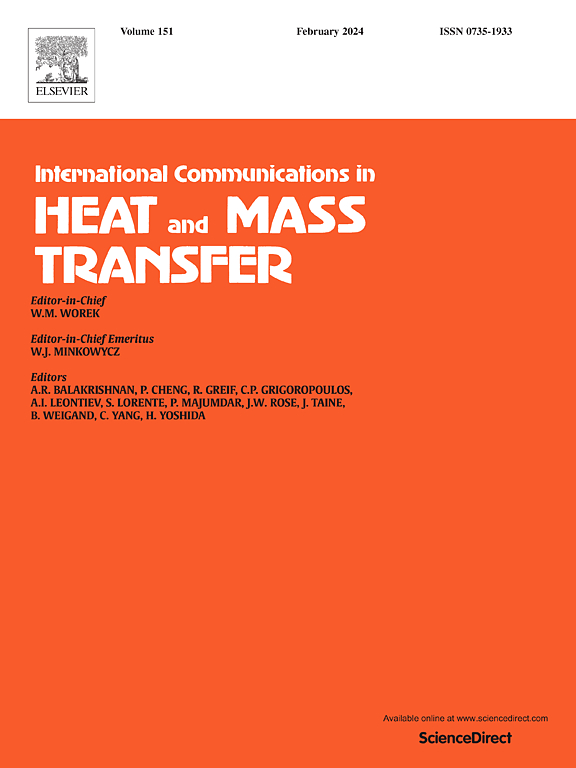Thermal conductivity in MoSi₂N₄(MoN)ₙ: Insights into phonon scattering and transport
IF 6.4
2区 工程技术
Q1 MECHANICS
International Communications in Heat and Mass Transfer
Pub Date : 2024-11-17
DOI:10.1016/j.icheatmasstransfer.2024.108361
引用次数: 0
Abstract
As nanoelectronics devices continue to shrink in size and increase in integration, managing heat effectively becomes essential for maintaining their stable operation. Two-dimensional (2D) materials, characterized by their superior thermal conductivity, and mechanical flexibility are considered excellent options for thermal management purposes. This study explores the thermal transport properties of 2D sandwich material MoSi2N4(MoN)n(n = 0–4) using Density Functional Theory and Neural Network Potential. We found that adding a layer of (MoN) on MoSi2N4 to form MoSi2N4(MoN)1 results in a significant decrease in thermal conductivity. We have provided a reasonable explanation for this phenomenon, discovering that it is due to the addition of a layer of (MoN) significantly shortening the phonon lifetime and the average free path of phonons. Furthermore, the addition of a layer of (MoN) leads to an increase in anharmonicity. However, when we continue to add more layers of (MoN), we find that the thermal conductivity no longer shows a significant decrease, but only a slight reduction. This indicates that as more layers of (MoN) are added, the scattering mechanisms reach saturation. These findings reveal the unique thermal behavior of 2D sandwich materials and offer valuable insights for their application in heat energy utilization and thermal management technologies.
MoSi₂N₄(MoN)ₙ中的导热性:声子散射和传输的见解
随着纳米电子器件尺寸的不断缩小和集成度的不断提高,有效管理热量对于保持器件的稳定运行至关重要。二维(2D)材料具有优异的导热性和机械灵活性,被认为是热管理的绝佳选择。本研究利用密度泛函理论和神经网络势能探讨了二维夹层材料 MoSi2N4(MoN)n(n = 0-4)的热传输特性。我们发现,在 MoSi2N4 上添加一层 (MoN) 形成 MoSi2N4(MoN)1 会导致热导率显著下降。我们对这一现象做出了合理的解释,发现这是由于添加了一层(MoN)大大缩短了声子的寿命和声子的平均自由路径。此外,添加一层(MoN)会导致非谐波性增加。然而,当我们继续添加更多层(MoN)时,我们发现热导率不再显著下降,而只是略有下降。这表明,随着(氮化钼)层数的增加,散射机制达到饱和。这些发现揭示了二维夹层材料独特的热行为,为其在热能利用和热管理技术中的应用提供了宝贵的启示。
本文章由计算机程序翻译,如有差异,请以英文原文为准。
求助全文
约1分钟内获得全文
求助全文
来源期刊
CiteScore
11.00
自引率
10.00%
发文量
648
审稿时长
32 days
期刊介绍:
International Communications in Heat and Mass Transfer serves as a world forum for the rapid dissemination of new ideas, new measurement techniques, preliminary findings of ongoing investigations, discussions, and criticisms in the field of heat and mass transfer. Two types of manuscript will be considered for publication: communications (short reports of new work or discussions of work which has already been published) and summaries (abstracts of reports, theses or manuscripts which are too long for publication in full). Together with its companion publication, International Journal of Heat and Mass Transfer, with which it shares the same Board of Editors, this journal is read by research workers and engineers throughout the world.

 求助内容:
求助内容: 应助结果提醒方式:
应助结果提醒方式:


